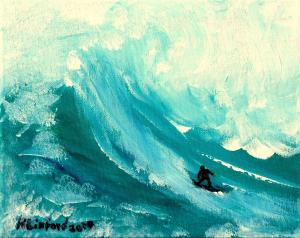Sale on canvas prints! Use code ABCXYZ at checkout for a special discount!

How to Paint with Acrylics:
Richard W Linford Fine Art Gallery
fineartamerica.
How to Paint with Acrylics
(c) Linford Corporation 2022
1. I enjoy painting with acrylics.
2. They are versatile.
3. They are modern.
4. Acrylics are made of a pigment, an acrylic binder, and water.
5. Acrylics are polymer-based.
6. They are like plastic.
7. Acrylics dry fast so you can overpaint and layer quickly.
8. They clean up easily with water.
9. They do not easily crack.
10. They are “archival.”
11. They are water resistant when dry.
12. Some acrylics dry darker as they dry.
13. They do retain their brilliance with age.
14. They are weather resistant.
15. Disadvantages --
16. They dry so fast.
17. This makes it difficult to blend the paint.
18. Avantages –
19. You can paint a number of paintings quickly.
20. You can use all of the oil based painting techniques.
21. You can use glazing.
22. You can thin acrylics.
23. You can paint over acrylics in rapid succession.
24. You can paint impasto style.
25. You can paint oil over acrylics.
26. How Acrylics Work and are Used -- a simplistic explanation –
27. The water evaporates.
28. A translucent film remains.
29. The paint reflects light and creates brilliance..
30. Acrylics can be thinned with water.
31. They can be thinned with an acrylic medium.
32. They can be used from the tube like oil paints.
33. They can be thinned with water and used like water color.
34. They can be placed on and used from a palette like oils if you keep them wet.
35. Watercolors and Oil Paints and Acrylics – compared to water colors –
36. Water color by contrast can be dissolved with a wet brush and or water.
37. Water color fades as it dries.
38. Acrylics darken as they dry.
39. Water colors need to be framed behind glass.
40. Acrylics do not.
41. Compared to oil paints, acrylics can be painted over in 60 minutes or less.
42. Acrylics can be painted on many surfaces and will not crack or split.
43. Acrylics do not require sizing of paper, cotton, linen, wood while oils most often do.
44. You can clean your brushes with soap and water which you cannot do with oils unless you use a water based oil.
45. As a general rule, acrylics and oils do not mix.
46. Acrylics are water based.
47. Oils are oil based.
48. Water and oil do not mix.
49. Oils take a great deal of time to dry -- weeks -- months -- years.
50. Cleaning your brushes and your palette?
51. To clean your brushes and your palette simply use water.
52. You can also use a liquid hand soap diluted or straight.
53. Clean the base of your brush thoroughly to avoid color build-up.
54. The technique for using acrylics like watercolors?
55. Thin your acrylics with water.
56. Or thinning your acrylics with acrylic medium.
57. This thinning creates a transparent watercolor.
58. You can use an additive Acrylic Flow Improver to give your acrylics the consistency of water colors.
59. The technique for using acrylics and oils together?
60. Separate your tubes of oil paints from your acrylics.
61. Otherwise, you will run the risk of grabbing an oil instead of an acrylic or vice versa.
62. With oils you normally paint an under painting or rough sketch which usually takes a long time to dry.
63. If you use an acrylic under painting you save an immense amount of drying time.
64. Acrylics adhere well to canvas or board or paper or most any other dry and oil free medium.
65. You can use a wash on your canvas.
66. You make a wash by diluting a mixture of the paint in water.
67. You can use a large brush and rough sketch your outlines.
68. Block in the areas you are going to paint.
69. Experiment with thin acrylics drawing and painting.
70. Then apply the oil over the under painting.
71. Or finish your painting in acrylic.
72. Make sure your acrylic under painting is dry.
73. Use turpentine or a mixture of turpentine and linseed oil to ensure that your initial coat of oil paint is thin.
74. You can extend the under painting using oils.
75. Texture?
76. Using acrylics, you can build up textures in minutes.
77. You can use your palette knife or various brushes or other tools.
78. You can then apply oil paint over the texture.
79. You can apply thicker and more substantial layers of oil to your painting.
80. The reason to apply your oils thinly at first is so you can follow your under painting lines.
81. Rubbing back?
82. Take a clean cloth and rub back the oil to reveal layers of acrylic.
83. An acrylic under painting supports and adds depth and luminosity to your oil painting.
84. Finishing?
85. To finish your acrylic painting, you may want to use an acrylic varnish to give additional protection.
86. Although that is not absolutely necessary.
87. Sources: http://www.madisonartshop.com/abaccol.html; http://www.essortment.com/all/oilsacrylicspa_rclh.htm